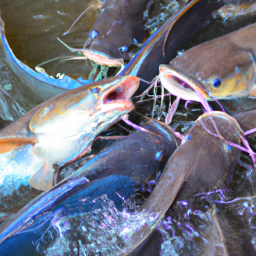Introduction
The Blue Catfish, scientifically known as Ictalurus furcatus, belongs to the family Ictaluridae. Often recognized for their strong capabilities to grow large, Blue Catfish is a freshwater species greatly admired by anglers.
Conservation Status
Flying in the face of the general trend for wildlife species, Blue Catfish is not considered threatened or endangered. Specifically, the IUCN Red List categorizes them as a species of ‘Least Concern’. However, in some areas there are efforts to manage the population to avoid causing impact on other aquatic species.
Statistics
| Statistic | Average | Range |
|---|---|---|
| Length | 25-46 inches | Up to 57 inches |
| Weight | 20-40 lbs | Up to 150 lbs |
| Average Lifespan | 20-30 years |
Distribution
Native to the United States, Blue Catfish are found predominantly in major river systems and large reservoirs in the Mississippi, Missouri and Ohio valley. They are also found in parts of Texas and the Gulf Coast region. These fish do not typically migrate.
Habitats
These catfish inhabit freshwater environments that range in temperature from 70-85 °F (preferably around 77 °F). They are typically found in deep, slow-moving waters with sandy or rocky bottoms.
When and Where to See
Although Blue Catfish are known to be more active during the night, they can often be seen during the day in the warmer months of May through August.
Best Fishing Locations
Top fishing destinations for Blue Catfish include:
- Mississippi River, U.S.
- Missouri River, U.S.
- Chesapeake Bay, U.S.
- James River, U.S.
- Lake Texoma, U.S.
- Red River, U.S.
- Wheeler Reservoir, U.S.
How to Catch
Fishing techniques often include bottom fishing or drift fishing using baits like shad, herring, and carp. Optimal fishing times are early morning or late at night, particularly during the summer months.
Identification Guide
Blue Catfish are identified by their whitish belly and silvery-blue above, a deeply forked tail, and a relatively straight-edged anal fin.
Culinary
Blue Catfish are highly prized for their firm, sweet-tasting white meat. They are typically prepared by grilling, frying, or baking and served with a variety of sauces or seasonings.
Additional Information
Blue Catfish are known to feed on a variety of smaller fish, crustaceans, and insects. They exhibit a spawning behavior, which involves the male catfish constructing nesting burrows in dark, secluded areas. Predators of Blue Catfish include large fish species and human fishing activities.

